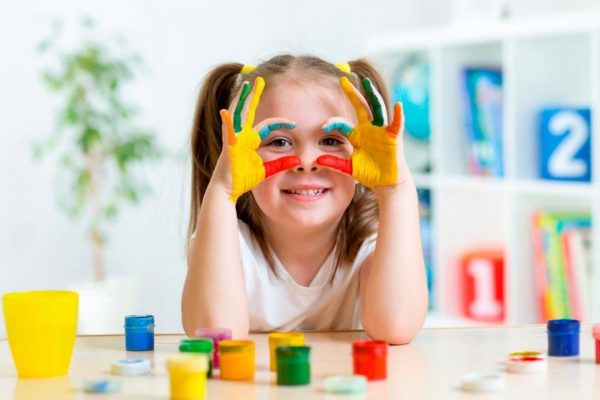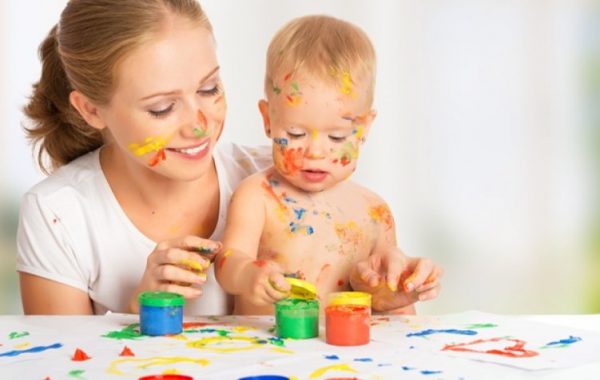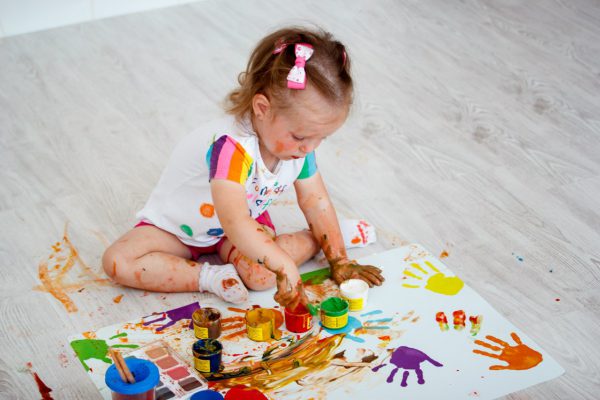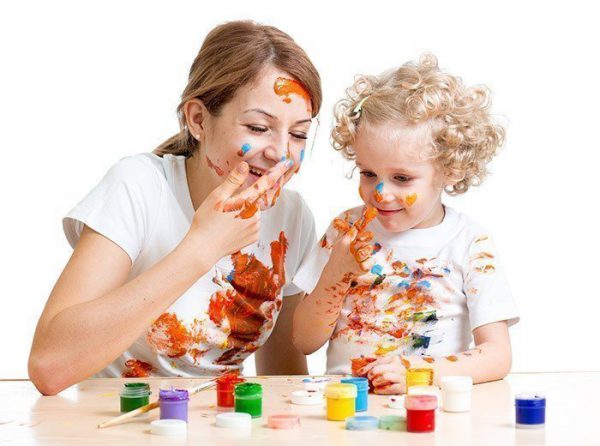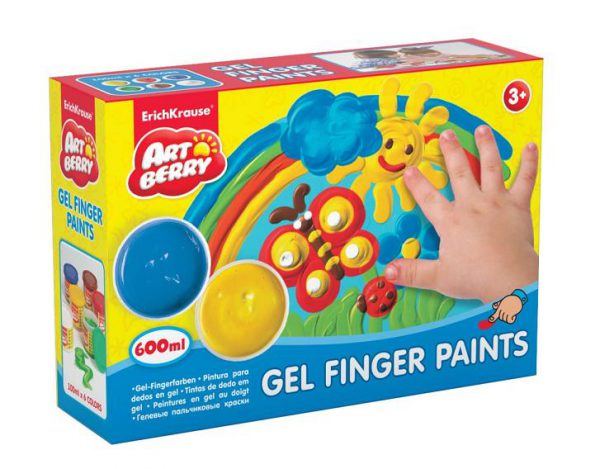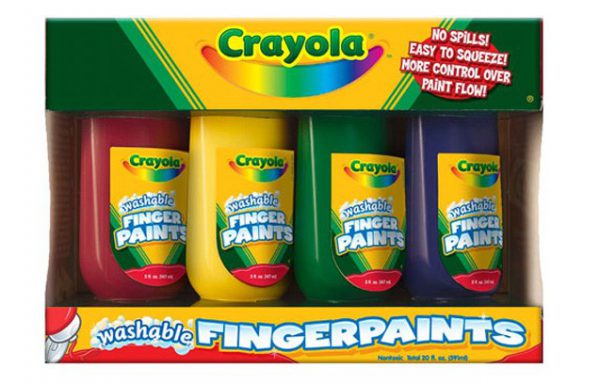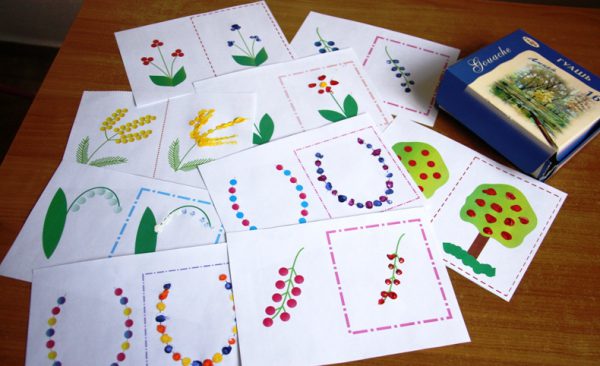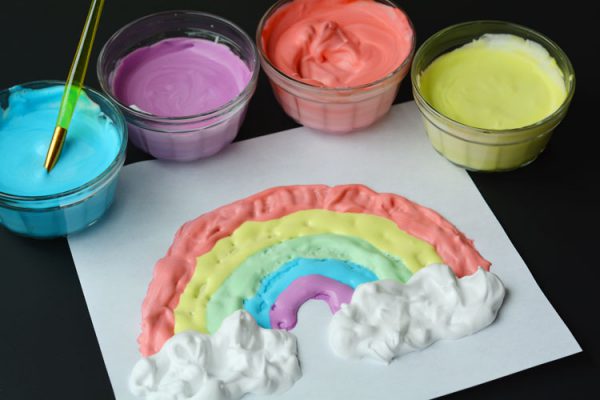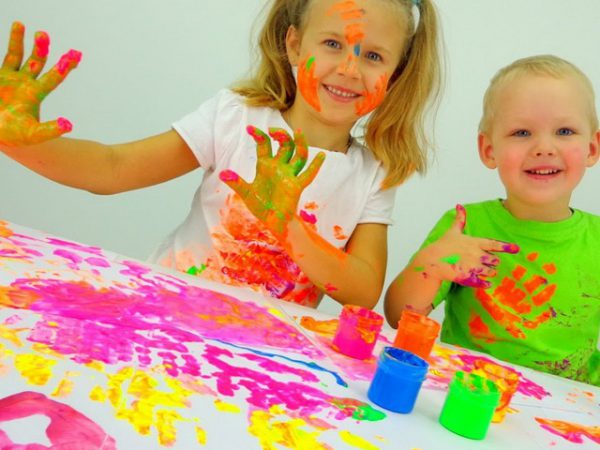Finger paints are an excellent tool for children's creativity, which will appeal to any child. Such paints are sold in most children's goods stores, but you can even make them yourself.
- The benefits of finger paints
- Age of use of paints
- Types and composition of paints
- Finger painting - process organization
- Child training
- DIY paints
- From starch
- From flour
- From shaving foam

There are many drawing techniques, although most children prefer to use their own imagination. All finger dyes should have an ideal composition without harmful components, because kids can even taste them.
to contents ↑The benefits of finger paints
Drawing with finger paints has a lot of advantages. The use of material from an early age (up to a year or later) helps to ensure the harmonious development of the child. Drawing for children is a fascinating process through which they learn the world, and do this with the help of visual perception and tactile (sensory) sensations.
The main advantage of using finger-type paints is their complete safety for the children's body. The child touches the material with his hands, can smear his face and body with it, so the composition of the pigments should be harmless.
Other advantages of the method:
- paints are quickly washed off with water, do not leave spots that the parent will have to wipe;
- paints do not flow, but lie beautifully on the surface, allow you to create original drawings;
- you can use paints on a wide variety of materials: pictures look great on paper, cardboard, glass, plastic, fabric, tile, ceramics and even on your own body;
- no expensive drawing equipment is needed - the child needs only a minimal set;
- for kids from 1 year old or a little younger to hold pencils, felt-tip pens are very difficult, and everyone will draw with a finger, palm;
- it will be interesting for older children to make pictures with such paints - even someone who does not know how to draw at all can easily learn in the game.
Why do most psychologists recommend classes with finger-type paints, what kind of beneficial effect do they have on a child? Some dads and mothers mistakenly think that children in the first year of life do not understand anything, so drawing will be meaningless.
For a child, the use of finger tinting is the purpose of obtaining pleasure, learning a new, unknown. During the process, new neural connections are created in the central nervous system, so the child begins to develop faster.
Useful qualities of paints:
- development of fine motor skills;
- acceleration of the formation of the nervous system;
- stimulation of the motor and thought centers;
- improving mental health, reducing the risk of psychological problems in the future;
- alignment of the emotional background.
Drawing helps to reassure the child if he is overexcited, and the use of bright colors activates those children who are too calm and phlegmatic from birth. Regular drawing lessons bring even greater benefits and are reflected in the development of the child as a person:
- Artistic taste.If you engage in creativity with your baby from an early age, the child will better understand the world around him with his colors, will be able to "transfer" what he saw on paper.
- Perception of flowers. Using fingers, a child will learn to combine colors, get different shades and see their diversity. Such children usually from the second or third year of life already know all the colors.
Age of use of paints
At what age can finger paints be used? If it is indicated on the paints that the material is not intended for children under three years of age, the child should not buy them: the composition contains components that are undesirable for ingestion.
Manufacturers often add bitter substances to finger colors, because this is a non-food product, it is impossible to consume it in large quantities. All paints for children under 3 years old can be used without any age restrictions. The main thing is that parents can provide control over the drawing process and not lose sight of the child.
It is best to wait until the baby can sit on its own and will show an active interest in drawing. Usually this happens in 9 - 10 months, although some babies can already practice drawing with their fingers for half a year. Manufacturers indicate the age of one year as recommended for the use of such products, based on reasonable restrictions and real hobbies of most children.
to contents ↑Types and composition of paints
Good paints that can be used by a child at home, consist of extremely simple ingredients: water, binders to create a thick base, pigments. The mass always remains thick, but not solid, if you do not leave it without a lid. For easy removal of color from the surface, juices, plant extracts, for example, aloe juice, can be added to it. On the box it should be indicated that these paints are intended for drawing with fingers (simple gouache is not suitable for this purpose).
The main types:
- gel - include special moisture-retaining substances, have a transparent texture, do not dry the skin, can be used by the youngest children;
- sensory - after drying, the picture will be rough, because special components are added to the material;
- fluorescent - after drying, the coloring will glow in the dark, further developing the child’s imagination.
Finger products for crumbs are usually sold in small sets - from 4 colors (red, yellow, blue, white). Such sets are suitable for the smallest children, for an older child it is recommended to buy a larger set (12 tones), with attached skewers, stencils, and other devices. With their help, you can colorize the pictures with great interest.
The most famous manufacturers of finger colors:
- Jovi. A Spanish brand that produces high quality paints that are sold worldwide. The colors are bright, the price is moderate.
- Djeco. Created in France, suitable for children under the age of one year. Many kits include plastic stencils that attach to jar lids. Even wooden toys, boxes can be painted with such paints.
- Crayola. American products, safe, very bright. Paints are easily washed off, have the highest quality. Less is a higher price.
- Ses. Dutch paints for allergy sufferers. They do not contain a single component that can cause allergic reactions in children.
Among Russian manufacturers, Kalyaka-Malyaka, Luch, Orange Elephant, Tsvetik, Molly, Trolls proved to be quite good.
to contents ↑Finger painting - process organization
How to draw with finger paints and keep the room clean? It is better to choose one place for classes so that the child gets used to it and does not go beyond the borders. A table will fit well, a corner on the floor. Carpets, paths must be removed or covered with oilcloth. You should protect the sofa, bed, other furniture that is nearby.
For the first time, it is better to draw on white paper - sheets A3, Whatman paper, and sheets A4 should be abandoned because of their small size. Clothing should be loose but easy to wash.You can even start the process in only panties, diapers, and then wash the child in the bathroom. Older children should give a special apron for classes.
How to dilute the paint if necessary? For this purpose, ordinary water is suitable, which must be prepared for classes.
to contents ↑
Child training
In the first lesson, it is important to show the child what the paints are for. You need to dip your finger in the color, draw it over the paper - so the child will understand that drawing is interesting and safe. When the baby is interested, you need to take his finger and repeat the manipulation. After it is worth giving the initiative into his hands: the child himself will choose the right tone and draw on paper. Parents can only control the work and often call the colors - so the baby will quickly remember them.
You can draw a picture after a few lessons. First, mom or dad shows the child how to do this, choosing the simplest option (for example, the sun). Children draw well grass, snow, rain, clouds. By drawing a rainbow, you can get to know all the colors at once.
As you grow older, you can apply various drawing techniques:
- Handprints. It is necessary to dip a palm in the paint, apply it to the paper, making a print. Next, you can make a flower out of such prints, draw a line with green paint, and make handprints in the form of leaves on it.
- Foot marks. Having smeared the child’s feet with finger tints, you can get original prints. In the future, they will help you find out how fast the crumb leg is growing.
- Sponge, sponge. An ordinary sponge absorbs paint very well, it is easily wrung out, so it can be used in creativity.
- Impressions, stencils. Included in the set of additional devices also help to create different forms, pictures. On sale there are often stamps, rollers, whole screen boards.
- Passepartout. After painting the picture, ready-made applications of colored paper are pasted onto it. For example, you can make a drawing of grass and flowers, and next to place two adult figures and a third - children's.
- Mixing tones. Even the four colors in the set are enough to produce various new shades, and the technique of combining colors should definitely be shown to the child. Instead of the palette, you can directly apply the crumbs palm.
- Coloring crafts. With the help of finger tinting, you can paint cubes, patterns - it will be interesting to children and adults.
After drawing, you need to dry the picture. It can be hung on the wall - let the child be proud of the work.
to contents ↑DIY paints
Finger paints are sold everywhere, but you can make them yourself. There are several recipes that use only available products.
From starch
Combine 3 tablespoons of sugar, half a teaspoon of salt, ½ cup starch, 300 ml of water. Enter any food coloring into the paint or divide the mass into parts and paint with different colors. Next, you need to heat the paint over low heat until the mixture acquires the consistency of sour cream. As pigments, you can take those that are used for coloring eggs. It is allowed to use juices of vegetables and fruits (for example, beets), but in this case they are introduced after the mass has cooled.
to contents ↑From flour
Stir 500 g of flour, 3 tablespoons of salt, 1 tablespoon of vegetable oil. Next, water is introduced until a “sour cream” texture is obtained, pigments are added after pouring into jars.
From shaving foam
Squeeze out a little shaving foam, add a small amount of gouache, honey watercolor. Homemade finger paints are ready. You can store them in jars of baby fruit and vegetable purees.
It is desirable that the finger colors are not pale - children do not like such colors, they are less interesting.It is better not to save on the purchase and purchase only the highest quality paints, given the shelf life, lack of toxicity and the reputation of the manufacturer.

